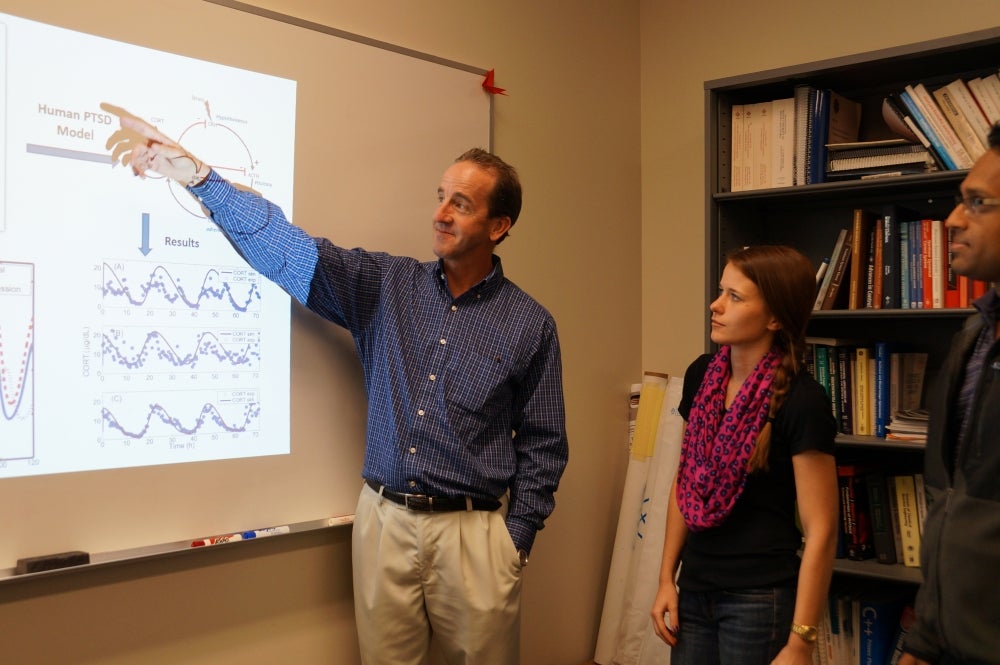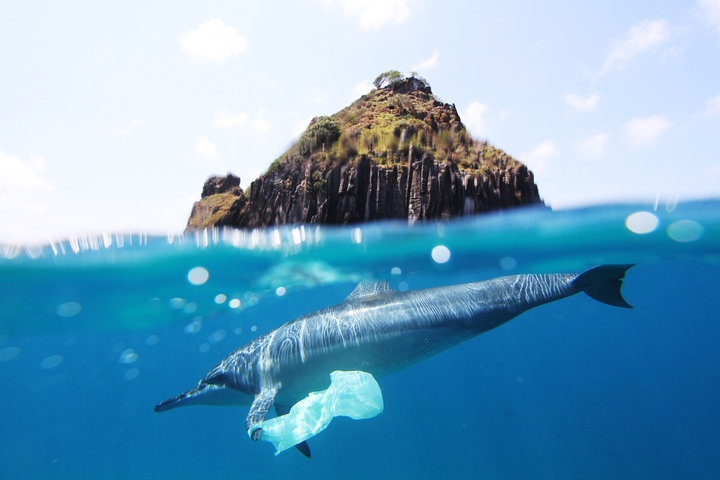Serving Those Who Have Served


Heroes. Warhorses. Ex-servicemen and women. Whatever your name for them, veterans are a major reason why the country exists, and Abraham Lincoln’s call to “care for him who shall have borne the battle” rings as true now as it did two centuries ago.
Today, more than ever in our history, we have the knowledge and the technology to take care of those who have gone into battle on behalf of the United States. Diagnostics and treatments being developed at UC Santa Barbara deal not only with obvious battlefield injuries but also with conditions that are less visible, and traumas that persist even after the wounds have scarred over.
Meanwhile, research continues to explore technology that can assist present and future military men and women in their duties, and training continues to develop individuals who are effective both in combat and in civilian life.
Seeking Early Signs of PTSD
It was called “soldier’s heart” in Lincoln’s time. Names like “shell shock” and “battle fatigue” also were given to the condition of returning soldiers who seemed to live and act as though they were still in the heat of combat, either fighting or fleeing seemingly invisible triggers. These days it’s called post-traumatic stress disorder (PTSD) and, according to Frank Doyle, professor of chemical engineering and of electrical and computer engineering, it can be detected in a patient’s bloodstream.
“Our goal is to have a portable (field-deployable) test kit that is a simple way for soldiers to test if they have PTSD,” said Doyle, who is working with a large collaborative multi-university team to develop the kit.
While the condition can be diagnosed after the veteran returns home, too often too many fall through the cracks, becoming addicted to drugs and alcohol, committing suicide or becoming a danger to others before there is a medical intervention. Early, accurate detection is key to returning the soldier to life without the haze of combat.
“In our approach, we monitor lots of molecules simultaneously, and we look for coordinated events that are linked by known network relationships, known as signaling pathways,” Doyle said. “We use combinations of tools for inference combined with computer models for simulation.”
In essence, Doyle said, the work lies in looking at a “symphony” of events that underlie the complex disease that is PTSD.
Solving the Mystery of Mild Traumatic Brain Injuries
When is a bump on the head not just a bump on the head? When it’s a mild traumatic brain injury (mTBI), more commonly known as a concussion. It’s an injury that can go unnoticed in standard scans and MRIs but has effects that can have a soldier’s doctors and loved ones scratching their own heads.
“If a patient with a concussion and lingering cognitive trouble goes in for a conventional brain scan, there’s less than a 3 percent chance of seeing something on the MRI,” said Scott Grafton, co-director of the Institute for Collaborative Biotechnologies and a professor of psychological and brain sciences.
About one in 10 people who experience these traumas never quite recover and instead embark on a downward trajectory of cognitive function. Grafton hypothesizes that conventional scans don’t pick up damage caused by mTBIs because the trauma happens at the level of individual neural connections as opposed to larger brain regions. These neural connections shear at their thinnest points, disconnecting parts of the brain, leading to cognitive and also physical decline.
Early intervention is key, and, to assist in an early diagnosis, Grafton and his team, in collaboration with research teams at the University of Pittsburgh and at Siemens, have developed a technique called diffusion spectrum imaging (DSI), which maps out areas of potential damage based on how water travels along the neuron’s axon bundle — the long thin portion that travels away from the main neuron body. The more diffuse the water, the theory goes, the higher the likelihood of a tear and loss of communication in the area.
The method is currently being tested on trauma patients locally and the program has been distributed to laboratories all over the country to gain additional data from other trauma patients. The outcome could, for soldier or civilian, make clear the difference between a truly minor bump on the head and the start of progressively worsening brain damage.
Buying Precious Time
A grave injury on the battlefield or in a remote area of the world is not the death sentence it used to be, thanks to a formulation for a blood-clotting gauze developed by professor of chemistry Galen Stucky and his team. After extensive testing by the Army and Navy, the gauze is now standard issue for the entire U.S. military command.
“Surprisingly, as of 2006, there was still no viable commercial solution for the prevention of either civilian or military deaths that resulted from traumatic wound arterial bleeding,” said Stucky, who also is a professor in the materials department of the College of Engineering.
The most effective blood-clotting powder (which was sprinkled directly on an open wound) and gauze in use prior to the Stucky team’s 2008 innovation caused second- and third-degree burns on the surrounding tissue, even as it stimulated the coagulation cascade needed to stanch the flow of blood.
With support provided by the Office of Naval Research and the Naval Medical Research Center to find a better way to stop the bleeding without causing additional tissue damage, the Stucky group found that with the blood clotting powder, the tendency to cause burns could not be resolved with the needed prevention of death. However, by determining how that agent activated the coagulation cascade, the group found other better alternatives that have enhanced rapid blood-clotting qualities.
The most cost- and performance-effective of these alternatives was kaolin clay, which while used for decades in medical laboratory clotting tests was unrecognized in the United States or globally in 2006 as a possible solution for the therapeutic treatment of arterial bleeding.
Rich in aluminosilicate nanoparticles, the clay — used often in making pottery — triggered the same clotting reaction as the original state-of-the-art material used in the field, but without the heat. An additional infusion of silver ions also enhanced the gauze’s antimicrobial properties. Not only has the advanced gauze improved the likelihood of survival for trauma patients at home and abroad, it also earned Stucky a 2008 Advanced Technology Applications for Combat Casualty Care Award from the U.S. Department of Defense.
Coagulopathy: A Mathematical Approach
Instantly after injury, the body works to repair itself. Platelets coalesce at the site of the wound to plug the hole, while coagulation factors activate further clotting to prevent blood loss.
However, any number of issues can complicate the complex blood coagulation process. Nutritional deficiencies, inherited conditions, disease and other abnormalities can contribute to the lack of healing or, worse, a preventable death. Whatever the cause, the problem is still the same: Blood fails to clot.
“Our goal is to understand the underlying mechanisms of coagulopathy — the failure of blood to coagulate after massive traumatic injuries,” said Linda Petzold, professor of computer science and also of mechanical engineering, on her work addressing the problem of coagulopathy. It’s a project she shares with other researchers, including H. Tom Soh, professor of materials and of mechanical engineering.
“Traumatic injury is obviously a problem on the battlefield,” Petzold said. “It is also a problem in civilian life, for example, from vehicle accidents.”
Through the development of mathematical models, the researchers hope to quantify their understanding of the coagulation process and validate them against in vitro and clinical data. They also are analyzing clinical data with the goal of classifying patient states and suggesting clinical interventions, Petzold said.
“This is a critical problem for both soldiers and civilians,” she said. “At the same time, there are numerous research challenges that make it exciting for us to work on.”
Better the Devil You Know
The possibility of concealed explosives is one that haunts virtually any military operation in hostile territory, as well as security operations on home soil. To tip the scales in favor of safety, Carl Meinhart, professor of mechanical engineering, and Martin Moskovits, professor of chemistry, have developed highly sensitive technology to sniff out traces of explosives in the air. This lab-on-a-chip technology could be put into a handheld chemical detector that can be taken anywhere hidden bombs are suspected, Meinhart said.
“We fabricate a microfluidic device that is the size of a thumbprint out of silicon,” he said. “In the microfluidic channel, we flow colloidal silver nanoparticles that are exposed to the atmosphere through a free surface.”
The colloidal silver nanoparticles act like little sponges, sopping up the explosive’s molecules and aggregating the tiny silver particles as a result. Read with a Raman spectrometer, the resulting spectrum is the molecular fingerprint of the potential hazard. The detection is rapid and precise, allowing life-saving decisions to be made.
“The ability to detect trace amounts of explosive vapors is an important societal need,” Meinhart said. “The threat of explosives to our military or in our cities and airports is a concern for all of society.
“As a researcher, I find it very gratifying when fundamental scientific research can have a demonstrable impact on society,” he said.
Training Tomorrow’s Leaders
For UCSB students like Alexander Moore, living up to one’s potential is not a choice between getting a college education and taking the opportunity to serve the country — not when he can do both. A senior in the university’s Reserve Officers’ Training Corps, Moore credits the ROTC for invaluable experience both inside the classroom and out in the field.
“Graduates of UCSB ROTC come away with a set of leadership tools and values that will stay with them for the rest of their lives,” Moore said. “ROTC graduates are socially, academically and culturally proficient because they benefit from not only a military education but also a civilian university experience.”
The learn-by-doing leadership the ROTC emphasizes has allowed him to face challenges in his life as a student and anticipate them after he graduates, he said. The rigorous mentorship program within ROTC has kept him focused on his academics as well. The financial support supplied by ROTC in the form of scholarships has also been a benefit in a time of ever-increasing costs of higher education.
Perhaps not as obvious — but just as important — is the particular connection the ROTC establishes between the program’s participants and the local community.
“ROTC also plays a big role in the Santa Barbara community, connecting with veterans organizations and volunteering at events from range cleanups on Camino Cielo to the Santa Barbara Veterans Day Marathon,” Moore said. “The community here has really embraced ROTC and it’s been great for everyone involved. I’ve had the opportunity to listen to veterans from every major war since World War II, all residents of Santa Barbara.”






